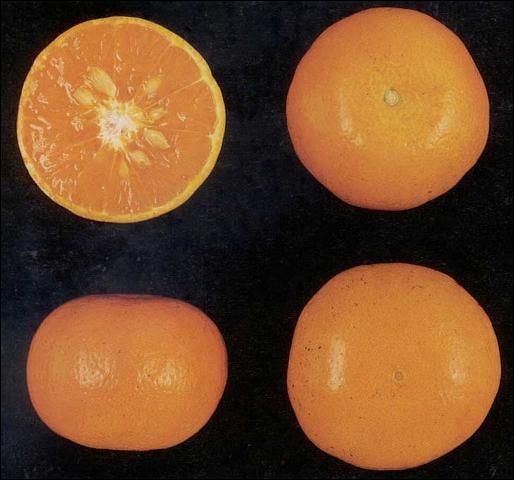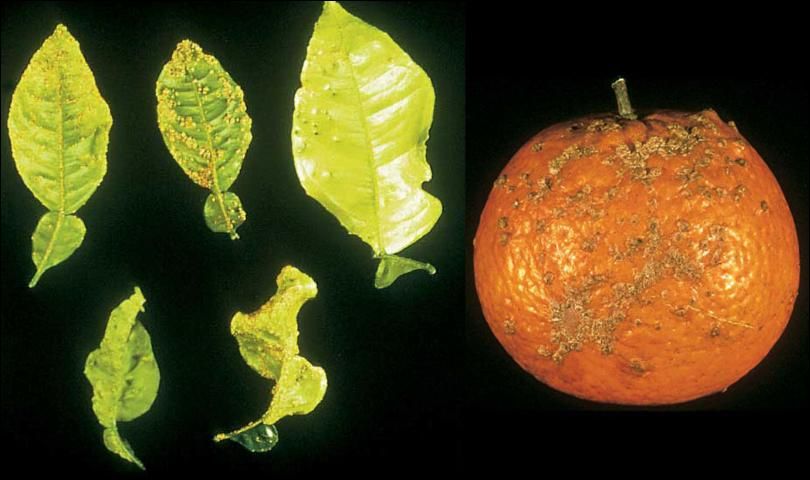Murcott (Honey Tangerine)
The actual origin of the Murcott (Figure 1) is unknown but is most likely a tangor, which is a cross between a tangerine and a sweet orange. The early history discusses the possibility that the variety originated in a USDA planting around 1916. In about 1922, early history states that Mr. Charles Murcott Smith had a nursery in Bayview, Pinellas County, Florida where several of these trees were located. Mr. Smith most likely obtained the original trees from the USDA.

Credit: UF/IFAS CREC
At the present time, it is the most widely grown late Florida tangerine and the fruit is marketed under the name Honey Tangerine; however, its official variety name is Murcott.
Fruit Characteristics
The Murcott fruit is medium in size, averaging from 2½-3 inches in diameter and has a shape that is typical of a true tangerine. The peel color is reddish orange and may be yellow orange in warmer winters, smooth, and while it can be peeled by hand it is somewhat more difficult to peel than a tangerine. The flesh is a rich orange color. Seed number will vary from 12 to 24 seeds per fruit and are white in color when cut.
The fruit matures in January-March making it the latest maturing tangerine type fruit, and it has excellent qualities for the fresh fruit market. The late maturation of the fruit may put it at risk in the event of a freeze.
The fruit and leaves are susceptible to citrus scab (Figure 2) and alternaria fungus disease. The fruit is produced on the end of the branches with the blossom end directed upward and this may result in sunburn or sunscald to exposed portions of the fruit.

Credit: UF/IFAS CREC
Tree Characteristics
Murcott trees are moderately vigorous and have a distinctive upright, willow-like growth habit. Since the fruit is produced on terminal end in clusters, the weight of the fruit will cause the branches to bend and lodge and sometimes break in years of heavy crops.
The rootstock of choice is Cleopatra mandarin as compatibility problems with some stocks have resulted at various locations before the trees reach about 10 years of age. This compatibility problem has resulted on Carrizo citrange, and caution should be used in planting on any trifoliate or trifoliate hybrid.
Murcott trees are cold hardy, but the fruit will not withstand freezing temperatures and maintain necessary quality for fresh markets.
Cultivation
Murcott trees will grow throughout the major citrus production areas of the state of Florida.
Field observations have resulted in the listed items that should be considered.
- In years of large crops, the nutritional requirements are increased due to the increased demand for both nitrogen and potassium. Murcotts will respond to high nitrogen and potash rates up to 400 lbs N and K2O per acre in heavy production years. Up to one-half of the fertilizer should be applied during the fall in several applications as the fruit is ripening. In years of light crops, reduced rates of fertilizer should be used.
- Murcotts are prone to alternate bearing. In cases of very large crops, root growth is limited and can result in tree death (referred to as Murcott collapse or Murcott decline). Growers should be aware of large crops and thin the fruit by pruning to reduce crop load to an acceptable level to prevent tree death. This pruning might require several light mechanical cuts or one heavy mechanical cut.
- In years of heavy cropping, small fruit size can also be a problem. By reducing the crop by pruning, the remaining crop should increase in fruit size.
- Fruit should be maintained in an acceptable manner as to make the fruit marketable for the fresh market. Murcott juice, while of good color, does contain limonin which reduces its uses in the juice markets.
- Unlike many of the hybrids, Murcott does not require cross pollination with other cultivars.
- Murcott as a variety is susceptible to xyloporosis regardless of the rootstock. Caution should be used in budwood selection to prevent the spread of xyloporosis into future plantings.
- In recent years, Huanglongbing (HLB), or citrus greening, has caused major tree decline of this variety. Many plantings of Murcotts have been removed.
More Information
Florida Citrus Production Guide: Citrus Scab, https://edis.ifas.ufl.edu/publication/CG020
Castle, W. S., D. P. H. Tucker, A. H. Krezdorn, and C. O. Youtsey. 1989. Rootstocks for Florida Citrus. SP-42. UF/IFAS Extension. p. 3.
Jackson, Larry K. and Frederick S. Davies. 1999. Citrus Growing in Florida, Fourth Edition. University Press of Florida, Gainesvile, FL. pp. 100-101.
Krezdorn, A.H. 1980. "Mandarin-Type Varieties — Problems Related to Excessive Fruiting." Florida Grower and Rancher. March 1980. p. 42.
Morgan, K.T. and D.M. Kadyampakeni. 2020 Nutrition of Florida Citrus Trees, Third Edition. SL253, UF/IFAS Extension https://edis.ifas.ufl.edu/publication/SS478
Morse, P.C., Jr. 1957. "History, Propagation and Distribution of the Murcott (Smith Tangerine)." Florida Tangerine Cooperative.
Saunt, James. 2000. Citrus Varieties of the World. Sinclair International Limited, Norwich, England. pp. 79-80.
Tucker, D. P. H., S. H. Futch, F. G. Gmitter, and M. C. Kesinger. 1998. Florida Citrus Varieties. SP-102. UF/IFAS Extension. p. 36.



